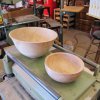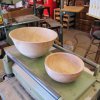Odie
Panning for Montana gold, with Betsy, the mule!
I have a rather large piece of spalted maple that is intended as a salad bowl. Right now, it's bare wood and sanded to 400. Is it a good idea to leave the bare wood aspect and finish only with a coating of Lemon Oil Wax?
How well would that combination work for food purpose? I expect there will be some staining from salad oils and veggies.......but can this be seen as something that can be expected, but not detrimental to the overall usefulness?
Should I use a sanding sealer as a base coat for this?
The wood, although has some spalt pattern to it, is still very solid......no detection of rot, or punkiness to it........
Comments, please.......
ooc
How well would that combination work for food purpose? I expect there will be some staining from salad oils and veggies.......but can this be seen as something that can be expected, but not detrimental to the overall usefulness?
Should I use a sanding sealer as a base coat for this?
The wood, although has some spalt pattern to it, is still very solid......no detection of rot, or punkiness to it........
Comments, please.......
ooc
Last edited:



